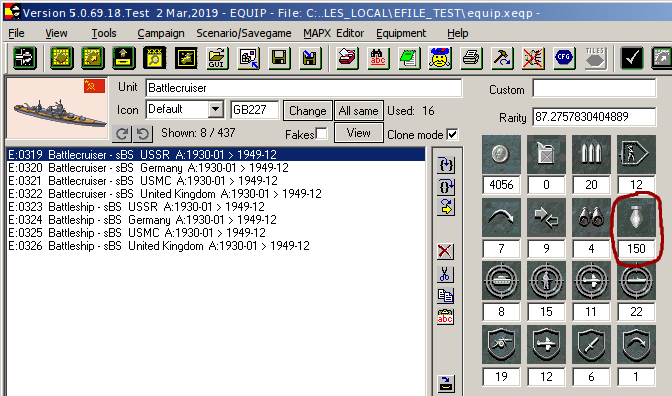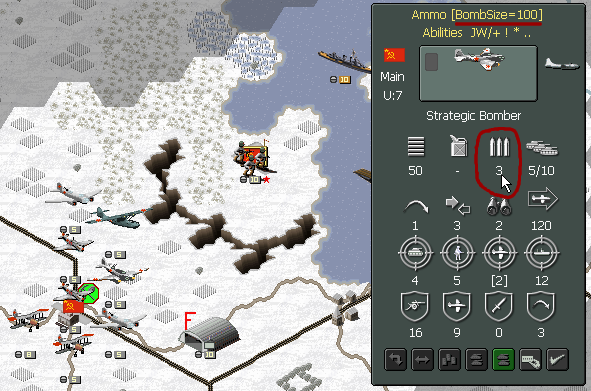FAQ entry
Keywords:
All,
attack,
barrage,
blow,
bomb size,
Open General,
unit classes,
What does the Bomb Size mean and what it is used for?
Bomb Size is a value in unit’s equipment data that has been expanded on Open General to allow some new features. It can be set using the Suite by typing a number in the Bomb Size box. See locate Bomb Size box in the Suite:

You can see the Bomb Size of an inspected unit by moving your mouse over the Ammo value:

Bomb Size actually means three different things:
- Any unit (in any class) with Bomb Size > 0 can inflict Lasting Suppression on the target. That is, any strength points suppressed during an attack will remain suppressed until the end of the turn. The actual Bomb Size value is not important. Note that currently, this effect is not displayed in the unit abilities. Also it does not depend on any scenario settings.
- Units in the following classes with Bomb Size > 0 may Barrage (see below) if scenario setting “Allow barrage fire” is enabled: Artillery, Tactical Bomber, Level Bomber, Battleship, Battle Cruiser, Cruiser, Light Cruiser. Higher Bomb Size values increase the effect.
- Same unit classes may Blow (see below) if scenario setting “Allow to BLOW…” is enabled. Higher Bomb Size values increase the likelihood to blow.
Barrage means two things:
- the ability to fire into unspotted hexes. Usually this applies only to artillery and ships of the classes listed above. But in theory could apply to torpedo-ability tactical bomber using ranged attack. If an enemy unit is in the unspotted hex, it may lose some strength, get some lasting suppression and get fuel/ammo reduced (similar to Level Bomber effect but with half efficiency). When there is any unspotted unit, then unit’s entrenchment is reduced by 1, hits counter is increased by 1 and chance to get unit damaged is: v = (unit strength * bomb size) / 50 + (unit strength * unit bars) / 5 . In addition Marksman leader adds 5, and if there is an OG minefield on the hex, then 10 is added to v. If bad weather result is halved. It is subjected to a maximum of 70. Then it is compared with random number between 1 and 100. If random number is <= v then unit suffers damage:
- A random number between 1 and v/10 is thrown; 1/3 of that number is converted on SP losses although limited to be less than unit strength/2 (so unit is never killed by this). Rest is lasting suppression.
- If hidden unit uses fuel, then fuel is also reduced using same formula than for LB but with half efficiency
- If hidden unit uses ammo, then ammo is also reduced using same formula than for LB but with half efficiency
- the ability for Level Bomber class only to inflict loss of prestige by attacking enemy-owned City, Port, or Airfield which is also a victory hex or supply hex. This effect is available even with Bomb Size = 0. The actual amount of prestige lost ranges from 0 to a maximum of 24 by this formula: (unit strength * bomb size) / 10 + (bars * 10) for fair weather. Other weather condition changes the last part of the formula to (bars * 5). Then the total is used to generate a random number between total/4 and total/2, and subjected to maximum of 24. In practice it means that a Bomb Value of 90 is guaranteed to deliver the maximum for a 10 strength unit with no experience, in poor weather. Even a Bomb Value of 50 will deliver the maximum effect most of the time in fair weather.
Blow means: to alter the terrain by an attack - allowed even if there is no enemy in the hex. The following terrain types may be blown: Airfield, Bridge, City, Fortification, Port, Rail, Road. A blown hex has the following effects:
- movement cost increases +2 to enter the blown hex
- movement cost increases +2 to exit blown city
- blown terrain can’t be used for its usual purpose - for example air units can’t resupply on blown airfield
- for infantry in blown city only: +1 to effective defense, and attacker get -1 to effective defense
Terrain can be blown either during normal combat or barrage but the probability is different:
During normal combat:
Blowing hexes is actually an un-wanted side-effect (collateral damage). Chance to blow is based on v = (unit strength * bomb size) / 200. If there is an OG minefield on the hex, then 10 is added to v. It is subjected to maximum of 85. Then it is compared with random number between 1 and 100. If random number is <= v then the hex will be blown. In practice it means that for a 10 SP unit:
- Minimal bomber size to blow hex while combat: 20, probability 1%
- Probability with max bomber size(255) = 12%
During barrage fire mode:
Chance to blow is higher as it is one of the main purposes for doing barrage, so different munition is supposed to be used. The formula giving the chance to blow (if scenario option is enabled) is: v = (unit strength * bomb size) / 30 + (unit strength * unit bars)/5. In addition Marksman leader adds 5, and if there is an OG minefield on the hex, then 10 is added to v. If bad weather result is halved. It is subjected to a minimum of 1 and maximum of 95. Then it is compared with random number between 1 and 100. If random number is <= v then the hex will be blown. In practice it means that with any bomb size > 0 there is chance to blow (1%) and with the maximum bomber size of 255, chance to blow is 85% (if no bars, no minefield and no leader) and never more than 95%
 Downloads | Documentation | Databases | Screenshots | Forum
Downloads | Documentation | Databases | Screenshots | Forum

